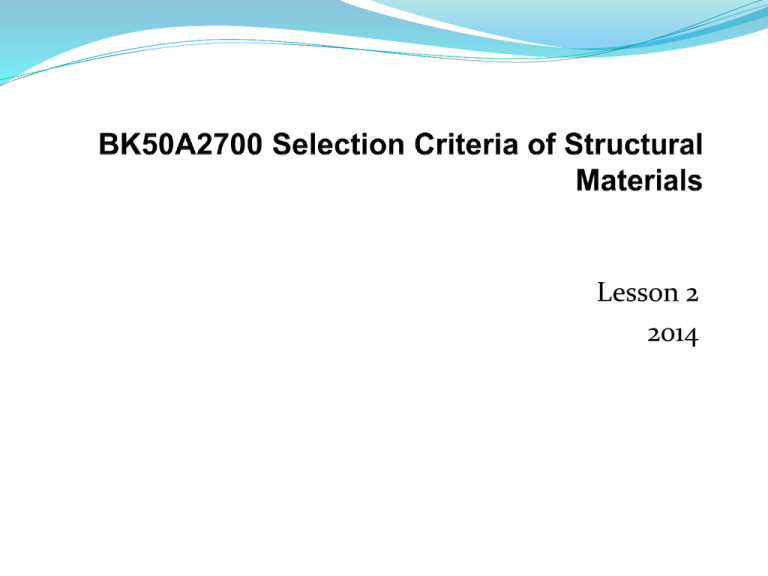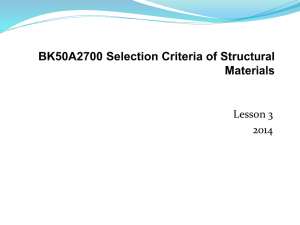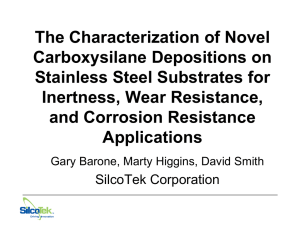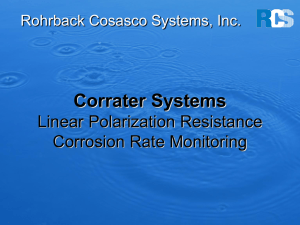Repetition 2
advertisement

Lesson 2 2014 Lesson 2 2014 Our goal is, that after this lesson, students are able to recognize the importance of affecting wear and corrosion phenomena for material selection. Note! To ensure proper material selection it is important to recognize the affecting wear phenomenon/ phenomena! ADHESIVE WEAR TRIBOCHEMICAL WEAR WEAR PHENOMENA ABRASIVE WEAR FATIGUE WEAR Note! Different wear phenomena can affect simultaneously Different wear phenomena can affect consecutively (they can form “chains” of wear phenomena) Numerical values of wear resistance are required to compare the wear resistance of optional materials objectively! - Lubricated - Non-lubricated - Self lubricated - Oil - Crease MATERIAL PAIR - HD - EHD LUBRICATION - Border CONDITIONS - Mixed - Slow speed - High speed - Continuous - Cyclic SURFACE ROUGHNESS MEDIA TYPE OF MOTION WEAR Main aspects in material selection - Adhesive WEAR - Abrasive PHENOMENA - Fatigue wear - Tribochemical wear ENVIRONMENTAL CONDITIONS ADHESIVE WEAR Surface 1 MOTION A surface peak cold welds with the surface peak on the opposite surface. Surface 2 ABRASIVE WEAR MOTION Surface 1 Harder A harder abrasive particle wears the softer surface. Surface 2 Sowter TRIBOCHEMICAL WEAR FATIGUE WEAR Carburized steel 20NiCrMo 5 Polymer PA6.6 FRICTION COEFFICIENT µ FRICTION COEFFICIENT µ PA 6.6 1 1 0.8 0.8 0.6 0.6 0.4 0.4 0.2 0.2 0 50 PA 6.6 + 15% PTFE 0 150 250 T [ºC] TEMPERATURE 50 150 250 T [ºC] TEMPERATURE Centrifugal cast bronze GZ-CuZn12 Carburized steel 16MnCr5 Heavy loads Wear resistance increases Small loads Heavy loads Thermal coatings WC/Co Wear restistance increases Thick CrC Thermal coatings ceramic CrN WC/Co coatings Plasma coating Borium steels Oxidation:Cr, Al Nitritized steels CrC, CrN Thin ceramic coatings Carburized steels Nitridized steels Carburized steels Austenic stainless steels Small loads Wear resistance steels are utilized e. g. in crane rails. Bearing steel 100Cr6 STRENGTH OF ADHESIVE REACTION Cr Ni Fe Ti Cu Al Zn Mg Sn Pb In In Pb Sn Mg Zn Al Cu Ti Fe Highly intensive adhesive reaction Ni Fairly intensive adhesive reaction Cr No adhesive reaction Archard’s equation : V =ki×F × s V = material loss due to wear ki = material pair coefficient F = affecting perpendicular force against the surface s = motion distance The criterion for wear resistance comparison is the material pair coefficient ki Advanced equations: V =Ki×SC2 × RC3 V S R Ki , C2,C3 = material loss due to wear = contact stress of the components = number of loading cycles = coefficient describing the material pair, surface roughness and loading case Advanced equation takes care of the effect of surface profile s and cyclic loading on wear Remember that sometimes the friction coefficient between the materials gives a measureable value for possible wear rate! Note! To ensure proper material selection it is important to recognize the affecting corrosion phenomenon! It is also necessary to take care of other simultaneous loading conditions with corrosion, such as tensile stress, temperature or wear! Numerical values are needed to evaluate and compare objectively the corrosion resistance of each optional material. See e.g. standards ISO 9223 and ISO 9224 for the corrosion speed of steels. C O R R O S I O N P H E N O M E N A Surface corrosion Uniform corrosion Pitting corrosion Localized corrosion Crevice corrosion High-temperature corrosion Galvanic corrosion Contact corrosion Mechanical surface loading Erosion Cavitation Fretting Corrosion under stress loading Selective corrosion Stress corrosion Corrosion fatigue Intergranular corrosion Bronzes Selective leaching Cast irons UNDER THE GASKET THERE IS THE RISK BOTH OF WEAR AND CORROSION EXAMPLE OF CRACK AND GALVANIC CORROSION ALUMINIUM BODY MW-FILTER FITTING BASED ON CLEARANCE RESONATOR PINS GOLD COATED CENTRE PIN SMACONNECTOR FRETTING CORROSION Clearance in fitting H6/m6 H6 Bearing assembly m6 STRESS σ FATIGUE WITHOUT CORROSION ENDURANCE LIMIT N NUMBER OF LOAD CYCLES MATERIAL PAIR CORROSION PHENOMENON TEMPERATURE STRESS CONDITIONS CHEMICAL ENVIRONMENTAL CORROSION Aspects to affect material selection - Uniform corrosion - Localized corrosion - Galvanic corrosion - Erosion and cavitation - Fretting - Intergranular corrosion - Selective leaching - Stress corrosion - Corrosion fatigue - Coating MANUFACTURING - Casting TECHNOLOGY - Painting Steel pipes in energy transportation CABLE JOINT STEEL/STAINLESS STEEL COATED POLYMERS ALUMINIUM ALLOYS COPPER ALLOYS SURFACE CORROSION OF THE HUB IN A CABLE JOINT Note! It is not enough to ”select” stainless steel to avoid corrosive damages! There are four different types of stainless steels and they have totally different application areas: Austenitic stainless steels Martensitic stainless steels Ferritic stainless steels Duplex steels CORROSION VELOCITY 10x µm/YEAR CONDITIONS x COUNTRY SIDE SEASIDE 4.5 4 3.5 3 2.5 2 1.5 1 0.5 0 A B C D A B C D A = AUSTENITIC STAINLESS STEEL B = FERRITIC STAINLESS STEEL C = ZINC COATED STEEL D = CARBON STEEL








